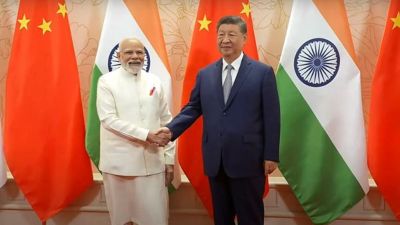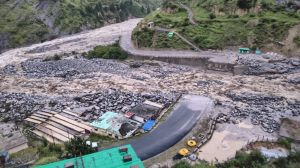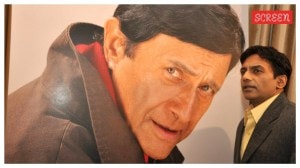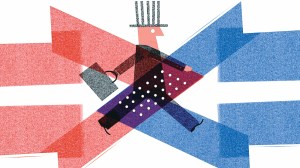Click here to join Express Pune WhatsApp channel and get a curated list of our stories
Against All Odds | ‘Half hour into flight, I collapsed with pain’: how Gartner’s India head survived emergency aboard Cathay Pacific
Partha Iyengar, an avid sportsman from his school days and a vegetarian who didn’t smoke or drink, suffered a massive heart attack, caused by a 100% blockage in the left anterior descending artery, on Mumbai-Sydney flight
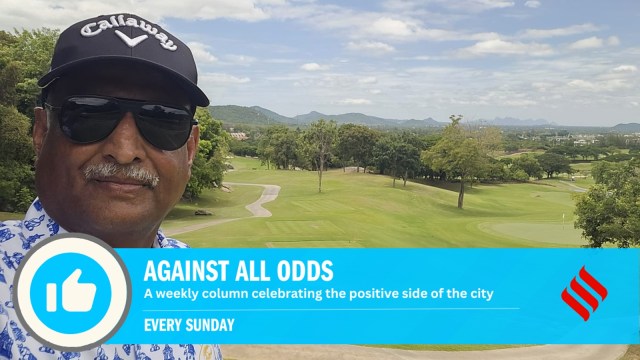 Iyengar worked in the US from 1986 to 1996 before returning to Pune to establish Gartner’s operations in India, as country manager. (Express Photo)
Iyengar worked in the US from 1986 to 1996 before returning to Pune to establish Gartner’s operations in India, as country manager. (Express Photo)On October 29, 2017, Partha Iyengar, India Country Head of Gartner, a research and advisory company, boarded a Cathay Pacific flight from Mumbai to Sydney. Unbeknownst to him, this routine business trip for a symposium was to turn into a mid-air medical emergency that would see the then 53-year-old fighting for his life, 30,000 ft above the ground.
A graduate of College of Engineering Pune (COEP) with an MS in Mechanical Engineering from New Jersey Institute of Technology, New Jersey, US, and an MBA from Rensselaer Polytechnic Institute, New York, Iyengar worked in the US from 1986 to 1996 before returning to Pune to establish Gartner’s operations in India, as country manager. His wife Jhumkee is an engineer with a master’s from IIT Mumbai and an MS from Tufts, US, while their son Rishi is a journalist in Washington DC, and their daughter Mitul is pursuing advanced studies in Design at Harvard.
Iyengar was an avid sportsman from his school days at Loyola Pune—where he played football and volleyball—and later a vegetarian who didn’t smoke or drink. In October 2017, a full medical check-up, including a stress test, gave him a clean chit.
 By early 2018, he was back to work, golf, football, volleyball, and biking. (Express Photo)
By early 2018, he was back to work, golf, football, volleyball, and biking. (Express Photo)
Still, there had been warning signs. “About a week before the flight, I felt this uneasiness, a sort of on and off pain in my chest,” he recalls. “A doctor friend dismissed it as acidity, so I left it at that.”
At Mumbai airport, as he walked to his gate, the discomfort resurfaced. He ignored it. But once he was airborne, things escalated dramatically. “By the time the plane reached cruising altitude, it was like a horse was kicking me in the chest. I was collapsing with pain, with just the seatbelt keeping me on the seat. I told the air hostess, ‘I think I’m having a heart attack,’” he says.
The cabin crew swung into action, paging for a doctor. A fellow passenger responded, gave him aspirin and Sorbitrate from the first-aid kit, and warned the pilots. The plane, now over the Andaman Sea, faced a crucial choice: continue to Hong Kong, the nearest major hub, or turn back.
‘A cartwheel in the sky’
“I told the air hostess, ‘I don’t think I will last till Hong Kong. You have to do something now.’” She conveyed the urgency to the captain, who made a bold decision. At the edge of Indian airspace near Bangladesh, the aircraft banked sharply, executing a 180-degree turn to re-enter India. “They did like a cartwheel in the sky,” Iyengar says, still marvelling at the manoeuvre. “Had they crossed into Bangladesh, returning would have been much more complicated.”
At 2 am, the plane landed in Kolkata, where an ambulance waited on the tarmac. Tests at a local hospital confirmed the worst: a massive heart attack, caused by a 100 per cent blockage in the left anterior descending (LAD) artery—the dreaded “widow maker”. With no space in its cardiac ward, his wife Jhumkee, calling from Pune, leaned on family connections to move him to Medica Superspecialty Hospital.
 “They did like a cartwheel in the sky,” Iyengar says, still marvelling at the manoeuvre.
“They did like a cartwheel in the sky,” Iyengar says, still marvelling at the manoeuvre.
By 8 am, the surgeons performed an emergency angioplasty, inserting two stents. “When they opened the artery, it was like someone poured cool water over my chest,” Iyengar remembers. His cardiologist later told him bluntly, “You are lucky to be alive. I don’t know how you survived this long.”
From the first chest pain around 1 am on the previous day to 8 am, it had been a race against time. His athletic lifestyle may have made the difference. “The cardiologist said my fitness created enough collateral blood flow to keep my heart going. Without that, I would not have made it past the golden hour,” Iyengar says.
Meanwhile, Rishi, who was then working in Delhi, managed logistics—informing his company since Iyengar was to present at Sydney, then flying to Kolkata, even as his mother took a flight from Pune.
 His wife Jhumkee is an engineer with a master’s from IIT Mumbai and an MS from Tufts, US, while their son Rishi is a journalist in Washington DC, and their daughter Mitul is pursuing advanced studies in Design at Harvard. (Express Photo)
His wife Jhumkee is an engineer with a master’s from IIT Mumbai and an MS from Tufts, US, while their son Rishi is a journalist in Washington DC, and their daughter Mitul is pursuing advanced studies in Design at Harvard. (Express Photo)
Recovery was slow but steady. After a week in the hospital, Iyengar returned to Pune for rest and physiotherapy. His heart’s pumping ability had dropped to 25–30 per cent, well below the normal 45–50 per cent. Over time, it has improved to about 40 per cent, and is expected to recover further.
No dramatic lifestyle changes
Unlike most cardiac survivors, Iyengar didn’t need dramatic lifestyle changes. “Though I had diabetes and BP, the usual trigger is cholesterol, and mine were perfect. The doctors finally put it down to heredity. Both my parents had heart issues. So I had to just watch my weight and ensure regular check-ups with my cardiologist, Dr Shirish Sathe,” Iyengar says.
By early 2018, he was back to work, golf, football, volleyball, and biking. In December 2024, Iyengar retired from Gartner but continues to consult and deliver talks, even as he pursues his passion for long-distance international biking trips.
Looking back, Iyengar reflects on the night that changed his life. “From chest pain at 30,000 ft to a near-miraculous landing in Kolkata, it all seems surreal. I was lucky, but now I am more proactive about my health,” he says.
Click here to join Express Pune WhatsApp channel and get a curated list of our stories


